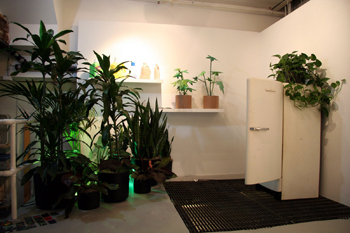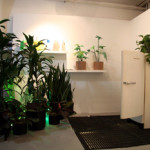By MARIA LACRETA
Femke likes to work for a specific space, and having been in Boston only eight months, she nearly immediately became the Associate Curator at Space Other on Wareham Street, working with Director and Curator Gamaliel Herrera. Space Other has continually shown provoking, original work that intrigues. She has continued to work independently as well, including “Great Apes” at Second Gallery, a collaboration she orchestrated for artists, scientists, and engineers to form a dialogue and create works together. Her most recent show is “Encounters”, at the Mills Gallery. This show deals with specific societies in places like Iran, Uzbekistan, and Russia--says Lutgerink, "Encounters is about the design of public life, and the idealogical regimes within these societies--it is about the translation and critiques of those living in these societies and how western medias depict them."
Education
In the Netherlands in the mid 90's, Femke Lutgerink was a student at the Royal Academy in Den Haag, where the history of the past permeates the city. Six months into her studies, Lutgerink began to question what she was doing as a photography student at Europe's oldest and well known academy of the arts. "There were lots of connections and networks put into place, but also two disadvantages—first, I was not an artist. I have lots of ideas but not a strong desire to execute them in that way."
Lutgerink liked what she thought of as the "practical side" of the Arts, practical applications she was getting in the studio, but her needs for being nurtured in the theory of art: more philosophy, more sociology, went missing. "Art history in high school," she mentions, "was better than what I found at the academy." The logical step was to leave the school.
After many long discussions with her theologian father—the decision to attend a University was reached. Femke transferred from Den Haag to the University of Amsterdam, where she began her major in art history. Lutgerink fills me in on what I understand as the formation of her philosophy as a curator. After two years at the University she began to look back at her time in the studio: "But here I was. I did miss the other side, I couldn't take any art classes because it is a separate academy you must attend—and this is also why I like the American system for those opportunities. I just wanted to take two or three courses."
Early Career
When I asked her how she dealt with this inhibition to develop she told me about studying under and developing a friendship with Jeroen Boomgaard, Professor of Art History at the University of Amsterdam, who helped plant the seed for a more interdisciplinary practice. Boomgaard recommended her for a curatorial internship with Martign Van Mieuwenhauzin, who was Director of SMBA, the Stedelijk Museum’s satellite space. Lutgerink adds, "Boomgaard now in fact has a lecture [course]about the University and Arts Academy crossover, and has established a great public arts program in the Netherlands." Her constant reflection on how these synergies are made is what makes the work she does as a curator stand strong. At the time her ideas were already bigger than what she was assigned for, "I had to say hey, look, this is boring here—a lot going on, but I don't really think you need an intern here—there is not enough work!"
Boomgaard's response was to make the connection for Femke with Martijn van Nieuwenhuyzen. Martijn the curator for SBMA (Stedelijk Museum Buro Amsterdam). Not long after the inception of the program in 1997 Boomgaard had asked Lutgerink to join on as an intern at SMBA, it later became her job and she stayed longer to finish the show "Real", which focused on Dutch artists in the region. The team worked with another curator from the photography department at the Stedelijk Museum: Hripsime Visser. This conveniently occurred during the same time frame in which Femke was writing her thesis on photography. "A literature study," she said in her poetic fumbled Dutch-English crosshatching about how photography was established as an art form. The purpose of the thesis was to give and highlight photography as its own language—without the rules of other traditional disciplines structuring what it needed to be.
The open call for the show at the Stedelijk space received a tremendous response from young artists—600 applicants. For artists, this begat commissions from the museum, and eventually it became a hot, annual exhibition. “For Real” was the title of this show Femke worked on with the team. Artists dealing with “reality” in their worlds was the thematic and included artists DeRijke and De Rooij. Needless to say, the curatorial internship at SMBA allowed Femke the freedom to work with concept development: talking to artists, figuring budgets and all that the curatorial world entails.
After finishing her master's thesis and graduating, she then made the next logical step: she worked in a kitchen for a stretch to decide what exactly that step would be. The Royal Academy, University of Amsterdam and SMBA all provided many contacts. Femke then started FEMME art projects and started to establish herself as an independent curator. Next came working at Impakt. Here, experience was gained interviewing artists, curators, and others in the field at the festival. One thing led to another and she landed a job working in the studios at the Rijksakademie, helping to coordinate visiting artists—not an ideal position, but yet another hot spot for networking. After encountering Dutch curator Nina Folkersma a number of times it seemed an obvious fate when Folkersma asked Femke if she wanted to start the process with her to "establish an arts organization."
The project proposal was a pilot for an arts space: The Quarantine Series, which was to be in four parts: On The Wall (Exhibitions), Off the Wall, (Events/Performances/Lecture), Wonderwall, and Paperwall. All installations were specifically made for the space, and so it was here when Femke really began to question ideas of crossing over and breaking up her understanding of art—what is an arts space after all? How do you curate to a space? How can you have a bar/restaurant next to art—does it sacrifice the quality? What are the merits to having an open arena where all can access the art?
Momentum
Each exhibition in this space (six a year) had an event attached to it, involving a heavy dose of documentation and documentaries about the installations. "Nina Folkersma was very important for me. Working with Nina—a very smart woman who taught me about what is what—who the producer is, what is the space, and how much say do you have in this dialogue with artists—she was very important for me, and taught me how to move around, how to think about the art world."
It seemed logical to take aspects from The Quarantine Series and fit it to a new agenda: to make a documentary about the Venice Biennale. Asking questions like, "Can an exhibition space produce their own work?" "What is this venue (Venice Biennale)?" "Why every two years?" And "What do people expect?" In 2004, the team set out to interview at the Biennale, and get some questions answered among the huge crowd with 6,000 press alone. They had the opportunity to talk with Okwui Enwezor, who had just served as Artistic Director of Documenta11 (1998-2002).
"Interviewing Okwui Enwezor at the Venice Biennale, we were able to ask about his use of documentary in the previous Documenta, and how that was seen as controversial---expanding the horizons and stretching the boundaries of it's use in a major contemporary art festival.” Lutergink continues, " and how to make this multi-cultural/ethnic group we are living in work, how to expand concerns and notions of what makes an interesting dialogue and the need to find a new language," In Venice, Enwezor, who was schooled at Cambridge (Oxford), and the first non-European as well as the first African to direct the festival, was surrounded by the city's colonial history and being the oldest art extravaganza of it's kind, served to be a provoking stage for such an interview. The entanglement seems in itself a weighty composite to decipher, "There were a lot of expectations of how this Director of the Venice Biennale would perform (Francesco Bonami)."
We began to delve into a conversation toward the end of our talk, which included many art soaked philosophers. Lutgerink is influenced as any thinking curator, by the likes of Barthes, Deleuze, Baudrillard, etc., but the most important element to that conversation is her note that "These people are very academic, but they do what they write.”
- Images from “Great Apes,” Femke Lutgerink’s curatorial efforts at Boston’s Second Gallery.
"Encounters" is on view April 6 - May 20, 2007 at The Mills Gallery, Boston Center For The Arts.
All images are courtesy of the artist and the Mills Gallery.






